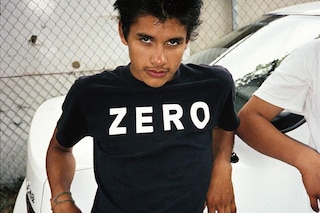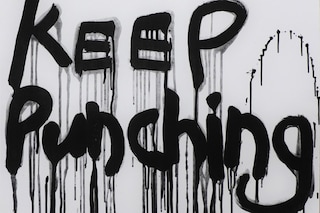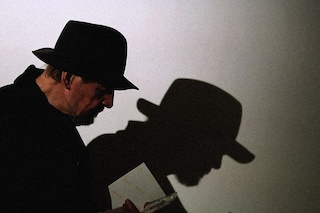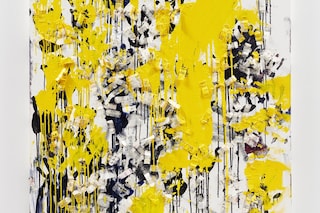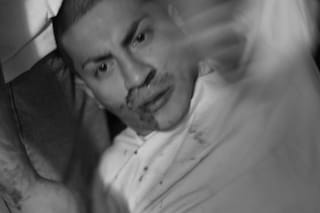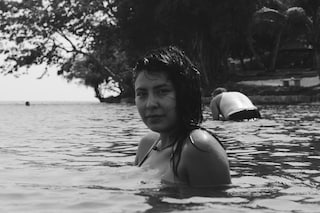During his last days in Paris, we meet the cult artist to talk about his Heroin paintings, how skate culture has evolved since Kids, and how he feels about going home
Larry Clark has always maintained a privileged, if at times complicated, relationship with France. As is the case with all epic romances set in the City of Lights, there have been moments of unbridled passion and betrayal, effortless style, fiery chatter and plenty of smoking. It is, after all, at the 1995 Cannes Film Festival that Kids was first unveiled outside the U.S. (in official competition, no less), and where he was both encouraged to make a film about contemporary French youths, while also being told he’d never be able to shoot such a film because he didn’t speak the language. Ah, le paradoxe.
When I walk up to the vibrant red façade of Galerie Rue Antoine on an otherwise grey-scaled cobblestone street in Paris’s Montmartre district, I’m expecting to come face-to-face with a committed, 74-year-old vegan who’s adjusted his body “to sleep 3-4 hours a night” and churn out a slew of ambitious projects while living in the French capital for Trump’s entire presidency. Needless to say, my expectations had been skewed by the press. Those statements had all been true at some point, but things move quickly when you’re Larry Clark – remember, this is the guy who learned to skate at 47, so don’t put anything past him. The taboo-busting artist, whose work has influenced the likes of Martin Scorsese, Nan Goldin and Frenchman Antoine D’Agata, was moving back to New York mere days after our chat, having reached the end of his one-year lease in Paris. “Now that the lease is up, I’m going back and I know it’ll just be Trump, Trump, Trump, 24/7,” he tells me with a palpable sense of resignation, but counteracts that grim prospect with the news he will soon become a granddad for the second time.
Clark, who is joined for the interview by friend and longstanding muse Jonathan Velasquez (of Wassup Rockers fame), was making one of his last visits to the gallery – the same wee space where hundreds of Parisians had recently flocked to in the hopes of snagging one of his democratically priced 100 Euro vintage photos (“my main audience is aged 14 to 24, so they could never afford those pictures in another context,” he reasons). It’s also inside this 18th arrondissement gallery where Clark and Velasquez are currently exhibiting a rotating selection of photographs, ranging from behind-the-scenes snapshots of Marfa Girl 2 to portraits of a mutual friend who lost his battle with heroin. As we settle in for our chat, Clark flashes the new algebraic ink on his forearm – a personalised equation courtesy of French “existential mathematician” Laurent Derobert – and confirms that the much-touted vegan diet had been scrapped indefinitely. “I’m not a vegan at the moment, I’m fat at the moment,” he deadpans. With that, Velasquez and the Tulsa photographer expound on U.S. politics, the changing fortunes of skate culture and their mysterious upcoming projects. We’ve channelled our inner Nouvelle Vague child by breaking down their thoughts into eight tableaux.
“Don’t challenge me because I’ll stand up” – Larry Clark
LA MUSE: JONATHAN VELASQUEZ’S CERTAIN JE NE SAIS QUOI
Clark met Velasquez in 2003, on an LA shoot for the French glossy Rebel. After returning three months later with a copy of the magazine for the South Central teen, the renegade photographer became his de facto soccer mom, driving Velasquez and his ragtag crew to skate around LA every weekend. “I agreed to pick them up one Saturday morning, and that evolved into me taking them skating for a year and a half. They would tell stories all the time and I would make notes in my diary,” recalls Clark. “I ended up with the screenplay for Wassup Rockers.”
Clark, who prides himself on picking out those with that elusive ‘It Factor’ from across a crowded room (think Kids’ Rosario Dawson or Marfa Girl’s Adam Mediano), explains what drew him to Jonathan – and all the others. “First of all, you see that the camera loves them. You can’t take a bad picture of Rosario or Jonathan. That’s very, very hard to do. So as a photographer, that’s the first thing you notice. Then you become friends with them. You like them, they like you, and here we are, sitting together, 14 years later.”
For the visual storyteller, who’s always immersed himself in environments for months if not years at a time, Velasquez provided the perfect opportunity to document an unfiltered transition from teendom to adulthood. Especially given that Velasquez has no qualms about appearing stark naked in Clark’s photographs, as made evident in Jonathan & Tiffany, a recently unveiled, limited edition photo book chronicling more than a decade’s worth of candid portraits of Clark’s two muses (Tiffany Limos starred as Peaches in 2002’s Ken Park). “It was put together very quickly, almost at random,” Clark clears up. “When I met Jonathan, I was with Tiffany, so it just made sense – no big revelations there.”
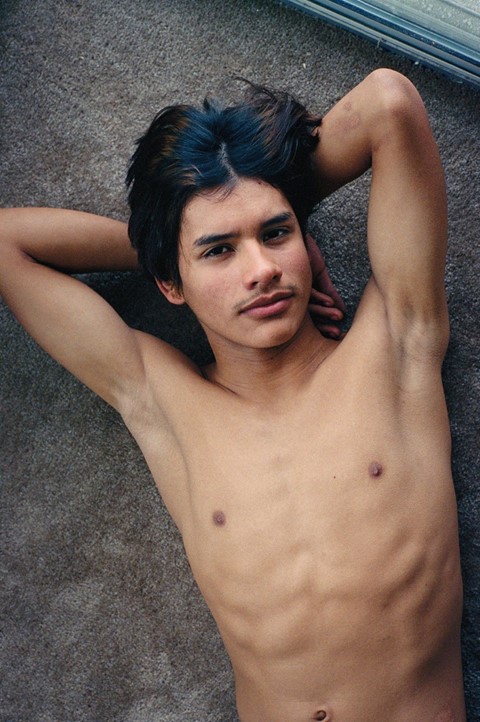
LE MYSTÈRE: FIVE WOMEN AND OTHER PROJECTS IN THE WORKS
Velasquez, whose band reVolt soundtracked Clark’s 2014 French skaters drama The Smell of Us, took up photography upon being inspired by Clark. He’s been snapping away on the same Leica M Monochrom Larry offered him as a gift, with some of those stills taking up wall space at Rue Antoine. Otherwise, Clark is tight-lipped about the many forthcoming projects you might have heard about through the grapevine. A project in Spanish shot in Mexico City, which he visited recently? “Maybe a film, but it’s all up in the air.” And while production has wrapped on Marfa Girl 2 – which “ends on the biggest cliff-hanger you could imagine,” he says – there’s also talk of another film that hones in on the “lifestyles and questions that arise as a result of social media use and online communications,” according to a gallery hand-out.
So what’s that about? “(Jonathan and I) are working on a film called Five Women, which is very difficult to write,” he begins. “And we have three women down so far. But there’s time. Hopefully, I’ll shoot it in 2018 at some point, maybe in Paris, maybe New York, perhaps both. I’m not sure yet. It’s about five women, and how their lives interact and don’t interact.” Hmmm, okay. “Most of the stories are true,” Jonathan says, chiming in. “Well, let’s not say that,” interrupts Larry, “because we don’t want to get sued.”
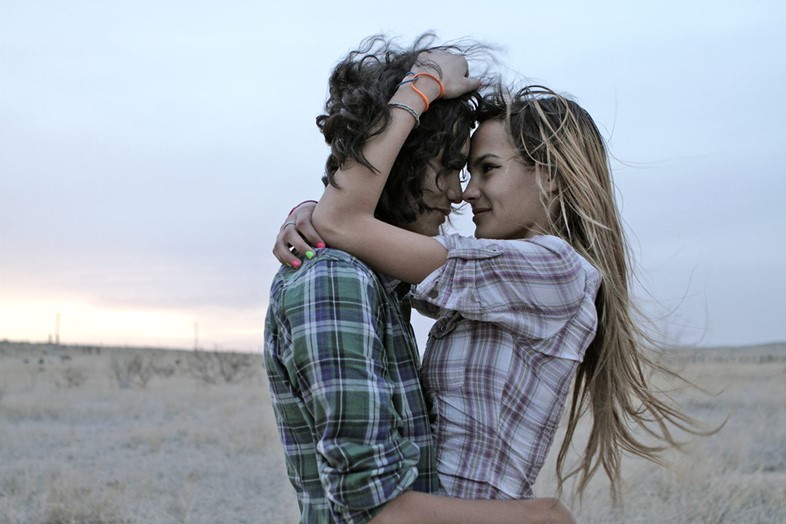
LA VILLE LUMIÈRE: IT’S ALL LOVE – AT TIMES, TOUGH LOVE – FOR THIS AMERICAN IN PARIS
“Don’t challenge me because I’ll stand up” is all Clark has to say when I bring up the French producers who once told him he’d never get a film off the ground in the République. Ultimately, that film got made as a result of another controversy. Back in the fall of 2010, Paris’s Museum of Modern Art presented the biggest retrospective yet of Clark’s work (“Kiss The Past Hello”, also a book). And city hall gave him the best PR boost he could have hoped for by forbidding entry to those under 18, citing “the pornographic and shocking nature of certain images.” It’s the kind of pearl-clutching response Clark’s work has long elicited, which only made him more curious to seek out those directly affected by the ban. His 2014 French-language debut, about a bunch of debauched skater youths from the 16ième arrondissement, came into being as a direct result of the exhibition.
“I’d be hanging my art on the walls of the Musée d’art moderne, then it would close and I’d go out through the back of the Palais (de Tokyo), in the area where all the skaters were,” remembers Clark. “I got the idea because it reminded me so much of Kids, when I was hanging out in Washington Square Park. So I decided to do The Smell of Us.” His recent stay in Paris has kept the septuagenarian quite occupied, and we’re not just talking about archival photo sales and gallery exhibitions. Clark was invited by artistic director Kris Van Assche to model for Dior’s AW16 menswear campaign and shoot a short film for the luxury brand about youths who turn the city into their playground, while also hosting a three-night residency at trendy new underground club Salò in January. And then there are the paintings.
LA DÉPENDANCE: THE INSPIRATION BEHIND CLARK’S HEROIN PAINTING SERIES
Larry Clark has always maintained that paintings and museum visits topped his totem pole of inspirations, because, unlike photographers, painters and sculptors weren’t bound by any rules. He only seriously took up the practice around 2011, working on portraits of Velasquez, when he realised he was more interested in the abstract backgrounds than the person taking up the bulk of the canvas. It was in Paris, during what he describes as the “very challenging and tense” shoot for The Smell of Us, that he turned to painting to tune out all the noise.
“I had gone through a series of spine operations in December 2013, after The Smell of Us,” remarks Clark when I inquire about his explosive Heroin series, on view at the nearby Galerie Hus until the end of the year. “They were terrible operations; I could have died. They spliced my throat and had to put 12 titanium screws in my spine, and then I had a second operation where both my knees were replaced, probably from learning to skateboard in my forties. So I had to recuperate for a year and the doctors gave me loads and loads of opiates. I became one of the millions of people in America addicted to opiates because the doctors had prescribed them. When they stopped giving them to me and I began to withdraw from the drugs, it reminded me of when I was a heroin addict. So I made the paintings called ‘Heroin’, #1 through #10. They were all inspired by the feelings I had while under the influence of opiates.”
Clark, who’s been heroin-free since 1998, remembers his encounters with Dorian, an aspiring actor who left his mark on those paintings. “This 24-year-old kid was a mutual friend of Jonathan and mine in New York,” he says, pointing to a monochrome portrait adorning the wall behind us, which Jonathan had taken. “He’d been a junkie since his early teens. He’d come up to my house after getting in trouble, would fix and then leave his dope bags. Like, pillowcases full of bags he’d collected for me, and which I incorporated into the paintings. I told him if he got clean, I’d make him a movie star and put him in my next film. So he got clean for about a year and a half. Then he had just one slip, OD’ed and died. Which happens every day.”
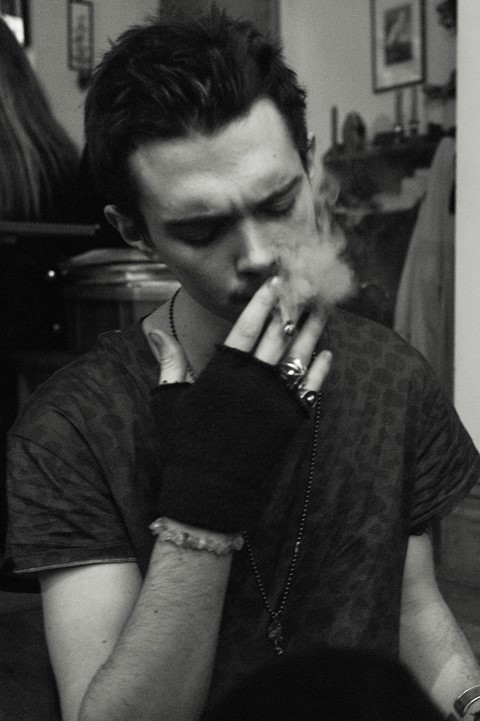
LES MARGINAUX: CLARK’S LIFELONG MOTIVATION
After a brief stint at Milwaukee’s Layton School of Art, Clark began capturing the bleak and unvarnished teenage experience of the 1960s in a way no one had previously dared to. He knew first-hand about the chaotic band of outsiders from his Tulsa hometown who’d opted out of the ‘American Dream’ myth, as he was one of them himself. The intimacy and lyricism of game-changing photo books such as Tulsa (1971) and Teenage Lust (1983) acknowledged the existence of these alternative societies operating on the margins. When I inquire whether the Paris and Los Angeles retrospectives have prompted him to look back on his career, he mentions wanting to shed light on small groups of outcasts. “I wasn’t thinking about it when I did the work, but looking back on it all now, through 50-60 years of work, I’ve always chosen small groups of people to photograph that you wouldn’t know about otherwise. Whether it’s Latino kids growing up in the South Central ghetto where no white people go, or the drug-taking teens and their alcoholic parents in Tulsa where I grew up, you wouldn’t know these people exist unless I told you about them. So that’s been my motivation throughout my career.”
“Whether it’s Latino kids growing up in the South Central ghetto where no white people go, or the drug-taking teens and their alcoholic parents in Tulsa where I grew up, you wouldn’t know these people exist unless I told you about them. So that’s been my motivation throughout my career” – Larry Clark
LA FOLIE: CLARK RECALLS THE VERY DIFFERENT ENERGIES PEOPLE BROUGHT TO THE SET OF BULLY
Responses to Clark’s work have invariably fallen into two opposing camps: those who argue he calls attention to the plight of the people that society has turned a blind eye to, and others who can’t get past the ‘exploitative’ charge. There’s perhaps no better example of this tenuous honesty/exploitation border zone than his tragic 2001 collage “Knoxville (Homage to Brad Renfro)”, about the drug-addled actor who starred in Bully. In this powerful photomontage, a destructive Renfro, who eventually died of an overdose in 2008, is seen shooting up cocaine in his underwear at his grandma’s Tennessee home, at the very moment when he should have been heading to Florida with Clark to film their true-crime drama. “He was such a natural,” recalls Clark about the performance he eventually got Renfro to deliver. “He was probably the best actor I’ve ever seen and he could do just about anything. He wouldn’t even read the script; I’d have to make him read the page and then he’d just do it. He was just amazing that way.”
Which brings us to Bully actor Daniel Franzese’s recent accusations about fellow cast member Bijou Phillips, who would’ve engaged in physical abuse, homophobic bullying and body shaming during the shoot. Clark mentions being caught off guard by the news, but he’s already spoken publicly about his own issues with Phillips, “the Paris Hilton of her time,” whose participation in the project unlocked much of Bully’s needed funding. “She was very, very difficult to work with and direct,” explains Clark. “I probably spent 90 per cent of the movie directing her. After the film, I said, you know there are going to be lots of directors wanting to hire her, thinking she’s this great actor – because of what I did. And then… you don’t see her around anymore, now do you?”

LA CONTRE-CULTURE: HOW THE SKATE SCENE HAS EVOLVED IN A POST-KIDS WORLD
Last month, as Vans unveiled its apparel collaboration with Clark, a cap with a short poem by the filmmaker reiterated his commitment to skate culture. “It took a 12-year-old boy to figure out the city was a concrete playground,” reads the inscription. Culturally, we’ve come a long way from the inner-city counterculture depicted in Kids, which allowed teens to channel their pent-up energies into something productive. If you missed the news, skateboarding is set to make its debut as an Olympic sport at the Tokyo 2020 Games.
A report from the Harold Hunter Foundation that at least two-thirds of skateboarders are now Black and Latino boys couldn’t make Clark any happier. “That’s totally different from what it used to be,” he says. “Jonathan lived in South Central, which is all Black and Latino, and there were so few, if any, Black skaters at the time. Probably a lot of skaters would have become gangbangers had it not been for the sport, so it makes me very happy to see how skateboarding has evolved. It’s a great, great sport and it has saved a lot of lives. It’s kind of like punk rock. If you listen to the lyrics in punk rock, they’re all about dysfunctional families. Punk rockers were very angry guys, and the skaters were the same at first. Skating kind of brought them out (and) gave them an outlet and a reason to live.”
There’s also a scene in 2005’s Wassup Rockers that hints at the casual racism of law enforcement in the face of non-white skaters. A Caucasian cop stops Jonathan’s character and his friends for the mere act of skating in Beverly Hills. As viewers, we’re able to laugh off this unsettling instance of racism because the gang ridicules him, giving the scene a light-hearted spin. But I wonder whether such a scene would resonate differently more than a decade later, in our very different political climate. “I think people are much more aware now,” explains Clark. “My experience at the time, what I observed among the police in LA, was that to them, anyone who was Latino was ‘Mexican’. Anyone who had brown skin was ‘Mexican’. There were no Guatemalans or Salvadorans, just Mexicans. And that scene actually happened to us, it’s based on fact. We all just stood there while they called in the police cars. We had gone to Beverly Hills High School to film the skating scene where they jump the stairs and slide the rail. That’s why we were there, but the cops didn’t believe us.”
LES RÉPUBLICAINS: CLARK REFLECTS ON THE COUNTRY HE’S RETURNING TO
Clark grew up at a very conservative moment in history: in Eisenhower’s purportedly wholesome 1950s America, which refused to acknowledge the existence of drugs, child abuse and a laundry list of societal ills. So how does he feel about the current state of US politics, as he’s about to fly home? “It’s much more conservative now – much more,” he answers without hesitation. “Trump really represents a whole other world. When I grew up, all the southern states were Democrat. When Lyndon Johnson got the Civil Rights Act passed in 1964, all the Democrats went Republican because they didn’t want civil rights or integration; they were totally against everything. When I was a kid, to be a Republican was the worst thing you could be. The best definition I’ve ever read of being a Republican was someone who can’t enjoy his supper unless he knows someone else is hungry.”
Peintures & Photographies by Larry Clark is on view at Galerie Hus and Galerie Rue Antoine in Paris until December 30, 2017


